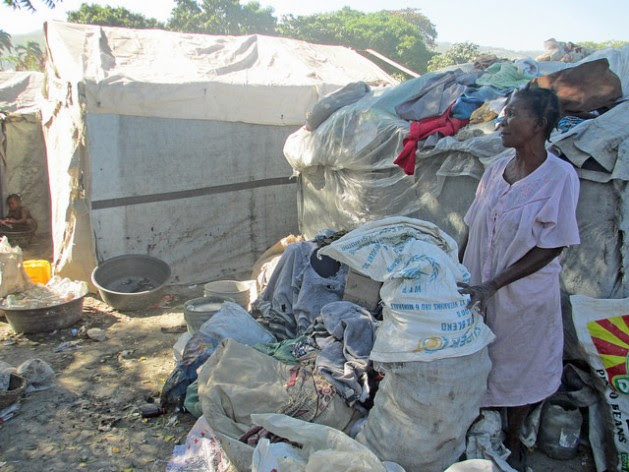 Mimose Gérard, 57, washes clothes and collects plastic bottles from the trash in order to survive. She is still living in a tent camp four years after Haiti’s earthquake. Credit: Milo Milfort/IPS
Mimose Gérard, 57, washes clothes and collects plastic bottles from the trash in order to survive. She is still living in a tent camp four years after Haiti’s earthquake. Credit: Milo Milfort/IPS
Carrefour, HAITI, (IPS) – Mimose Gérard sits in her tent at Gaston Margron camp, surrounded by large bags filled with plastic bottles. She earns just pennies for each, but that’s better than nothing.
“I’ve lived in the camp since Jan. 13, 2010, when I was set up with a tent. It’s been a painful existence,” she tells IPS. “I’m just a regular person on this piece of land. I have nowhere to go.”
Collecting bottles to recycle is the livelihood of at least a dozen people in this camp that about 800 families call home, located in Carrefour, on the southern edge of Port-au-Prince. Four years after the earthquake, there are still about 300 internally displaced person (IDP) camps mostly scattered around the capital region, and in a large new slum on desertic slopes outside the city.
Gérard is 57 years old, and has 11 children. She also does laundry to earn a few more pennies. Her hands are rough and chapped.
“The conditions are inhumane, but we have nowhere to go. Those whose families helped them have gotten out. But I don’t have anything like that, so I am staying,” she says.
Gérard added that residents are also forced to consume untreated water – in a country gripped by a cholera epidemic.
“We have no toilet. This is where people drop off their bag of fecal matter,” she says, pointing to a weedy area where residents open or dispose of the little plastic bags used as “portable toilets” in the night, when it can be dangerous to leave one’s tent.
On top of thieves, camp residents have to deal with the police and armed men working for landowners.
“The police try to force us to leave the camp,” Gérard claimed. Officers appear and shoot in the air, trying to scare residents. “The owner himself has come three times.”
Related IPS Articles
According to the U.N., residents in about one-third of the 300 or so remaining camps are at risk of eviction.
On Jan. 11, the eve of the fourth anniversary of the earthquake, an inferno raced through the 100 or so tents and shacks on a camp in Delmas, not far from downtown Port-au-Prince. Four people – a 38-year-old woman and three small children – were burned to death and dozens injured.
Aside from transporting some victims to the public hospital and handing out mattresses, municipal and federal authorities have not made any statements, nor have they launched an investigation into the origin of the blaze, which many suspect was arson. The land is owned by a Haitian printing company.
“Four people died in the fire, including three young children, whilst around thirty others were hospitalized with burns. All of the makeshift shelters of the 108 families who lived in the camp were completely destroyed by the flames, along with their personal belongings,” Amnesty International noted in a statement released on Jan. 17.
Sanon Renel, leader of the Front for Reflection and Action on the Housing (FRAKKA) coalition, said the murderous fire and the lack of official response do not augur well.
“It seems like the private sector is stepping up its evictions,” he told IPS. “They realise that the government practically supports their actions, so they can do whatever they want.”
“It’s repugnant to see how authorities treat people because of the simple fact that they are poor,” he continued. “They don’t consider them as human beings. I think they see them as animals.”
Four years vs. 35 seconds
Thirty-five seconds. That’s all it took the 7.0 magnitude earthquake that hit Haiti on Jan. 12, 2010 to wipe out almost a quarter of a million people, collapse almost half a million buildings – leaving 1.5 million people homeless – and trigger widespread destruction. The estimated cost of damages to the housing sector alone almost hit 2.5 billion dollars.
Four years later, some 200,000 people are still stuck in camps, like Gérard. Only 7,515 new permanent houses have been built while 27,000 have been repaired, and about 55,000 families have received one-time payments of about 500 dollars to leave the camps.
But a year later, those families “face another housing crisis as their housing subsidy runs out,” a recent study from the Washington-based Institute for Justice and Democracy in Haiti found.
A U.S. government plan to build 15,000 new houses has reduced its goals by over 80 percent, according to the Centre for Economic Policy and Research (CEPR). Now the plan is to build only 2,500. Although USAID, the U.S. Agency for International Development, has built over 900 houses in Haiti, it has decided to withdraw continuance.
Overall, of the 6.43 billion dollars disbursed by bilateral and multilateral donors to Haiti from 2010 to 2012, just nine percent went through the Haitian government while the rest went to foreign contractors.
“It’s a really profitable business for U.S. contractors to make money off of this disaster,” CEPR’s Dan Beeton told IPS. “This was an opportunity to turn a disaster into something that could benefit Haitians as they rebuild their own country, but they were just bypassed.”
“I’ll pick up pots in the street and get 20 to 25 gourdes [46 to 57 cents],” she says. “Every morning when we wake up, we pick up bags of feces and go throw them in a hole. The stench prevents us from cooking.”
Like Gérard, Ilien deplores the lack of potable water.
“When the camp was first built we had drinking water, but not anymore,” she says. “The water we drink isn’t good.”
Nor surprisingly, Ilien and other camp residents are afraid of being infected with any one of Haiti’s water-borne diseases, particularly cholera. Studies by numerous authorities, incuding the U.S. Centres for Disease Control (CDC), say the bacteria was brought to Haiti by Nepali peacekeepers who are part of the 9,500‑strong U.N. Stabilisation Mission in Haiti (MINUSTAH).
Introduced to the country in October 2010, to date it has infected almost 700,000 people, killing almost 8,500 of them. The CDC says that approximately two people per day still die from cholera. While U.N. agencies consider it an epidemic and a humanitarian crisis, so far the body has refused demands for compensation.
“Cholera and housing are being ignored, but they do go together,” Beeton says. “There’s no clean water, so the disease will spread. Cholera eradication is also lack of political will.”
The U.N. has 18 organisations – including MINUSTAH – currently operating in Haiti. They collaborate with approximately 43 large non-governmental organsations or NGOs, the World Bank, the International Monetary Fund, the government, and hundreds of smaller agencies.
Reduced funding, however, has caused humanitarian assistance to dwindle, although MINUSTAH’s approved budget has remained high – almost 577 million dollars for July 2013 to June 2014.
“MINUSTAH is a waste of money, in my opinion, because there is no armed conflict in Haiti, and the money could instead be spent on ending the cholera epidemic that MINUSTAH troops started,” Beeton said.
UN-Habitat notes that Haiti already had an immense deficit in adequate housing dating back before the earthquake, with many living in slum areas.
“We are clearly out of the emergency stage and we will allow Haiti to take care of itself, but that cannot go forward unless there are means,” a spokesperson for the agency told IPS.
With additional reporting by Lorraine Farquharson at the United Nations.















